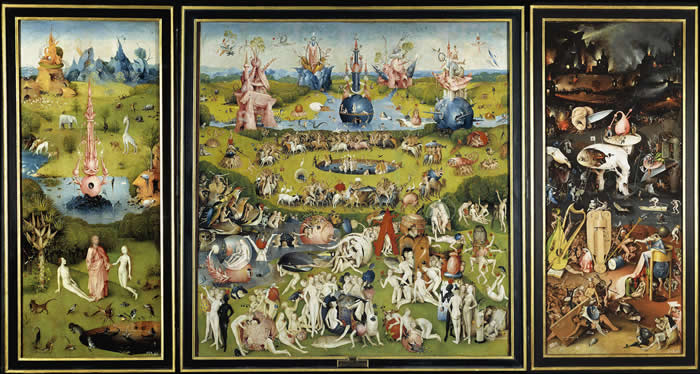
The Garden of Earthly Delights
-commentaries by Lee van Laer
Slide show, left panel, with full commentary
Slide show, center panel, with full commentary
Slide show, right panel, with full commentary
Hieronymus Bosch's "The Garden of Earthly Delights" stands as one of the greatest masterpieces of the Northern Renaissance —or, indeed, any age. I first saw the painting at the age of nine in the Prado Museum in Madrid, where — to the consternation of my parents — I spent several hours inspecting it. Even at that age, it made a deep impression on me, because I understood that it was trying to convey something extraordinary.
The painting has baffled viewers and experts alike for many centuries. It turns out, however, that the painting is a legible document if one understands the iconography and symbolism Bosch employed, along with the gist of his underlying message. It furthermore displays an unusual relationship to Buddhist Tantric art, which is more fully explained in the commentary.
Despite the many confusing and openly conjectural interpretations various expert art historians have offered over the centuries, Bosch actually left little to chance in ensuring his viewers could understand his message. The painting incorporates a wide variety of well thought out, remarkably deliberate devices to indicate the meaning of images, most of which are not anywhere near as obscure as once assumed. It represents a unified and continuous narrative—and, as one might expect, every single image in it is entirely integrated into that story. Because of a historical and chronic failure to understand many of the simple and—in the end, sometimes rather obvious— symbolic devices Bosch used, the narrative in this painting has not been appreciated until now.
Paradoxically, that narrative is both ordinary enough for the average man to understand it, and extraordinary enough to challenge the understanding of sages. This is because the painting works on a number of levels, and, in fact, is constructed in visual levels, as well as layers of meaning.
As you read on, you will discover that the dialogue Bosch engages in is an esoteric — or inner — description of man's spiritual nature; and that the devices and ideas he presents, although they may not be familiar to art historians or the public, are in fact well known to students of esoteric and religious philosophy.
Once one arrives at an initial understanding, the painting yields extraordinary depths, with layer after layer of meaning. In this sense, it is without any doubt the most sophisticated piece of esoteric religious art in western history. Bosch's sheer ingenuity in finding visual ways to encode well-known elements of esoteric doctrine is nothing short of staggering. Some of the devices in it so far out class other attempts of its kind that one wonders whether it did not come out the same esoteric schools that produced the Cathedral at Chartres— which, in point of fact, it probably did.
The secret societies of the Virgin that produced Chartres in the Middle Ages had, by the Renaissance, lost the ability to pass their knowledge along by means of massive pieces of architecture. They set themselves, it appears, the task of doing that with paintings — and Hieronymus Bosch was the master of both that school and that effort. (The similarities between the Cathedral at Chartres, with its bizarre gargoyles and cryptic figures everywhere, and this painting are already striking.) This art, in other words, was produced what Gurdjieff or Ouspensky would have called the group work of an esoteric school — and once they were finished, it disbanded, which is why no other works that equal these were ever completed. That, again, is how esoteric schools have always done their work — at least, that is, according to Gurdjieff.
The links will take you to an explanation of the artist's intentions, with detailed commentary on every figure and action in the painting, which will not be complete mysteries once you are done. And you'll see that this painting represents what is without doubt the single greatest symbolic use of imagery ever achieved in western art.
A commentary on Bosch's symbolism
Contact
Lee's blog on esoteric matters
Other esoteric studies
A Doremishock resource; all material copyright 2013 by Lee van Laer